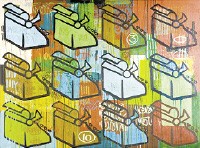In each of Matt Ducklo’s six large color photographs on display in “Touch Tour Pictures” at Power House, a blind person explores a sculptural masterwork with his or her hands. A woman at the Museum of Modern Art presses her hands against the base of Barnett Newman’s Broken Obelisk, arches back her head, and appears to “see” (feel, intuit, sense) the huge piece of steel towering above her. In a photograph taken outside the Memphis Brooks Museum of Art, a man traces the sinewy musculature of an archetypal figure killing an animal in Jacques Lipchitz’ Sacrifice III.
In a third image, a young woman hugs an eroded statute of Hatshetsup at the Metropolitan Museum of Art. Rather than evoking our inevitable decay and demise, she reminds us of our capacity to wrap mind and imagination around eons of time. Her long, slender hands bring to mind the sculptor who carved the stone. Her arms replace the appendages lying inert down the front of the ancient figure and remind us that Hatshetsup was once a woman who ruled all of Egypt.
Time stops altogether in one of Ducklo’s images. Light pours through a window of the Dixon Gallery, dissolves the right side of the picture, and shines along the body of a boy. Standing, his head bowed, he cups the face of Auguste Rodin’s 1868 masterwork, Girl with Flowers in Her Hair. In front of Ducklo’s beautifully composed, richly metaphorical images, we also pause and stand transfixed.
Matt Ducklo: “Touch Tour Pictures” at Power House through May 31st
In his exhibition “New Paintings” at Jay Etkin Gallery, Johnny Taylor captures the heroes, the memories and memorabilia, and the pop art/graffiti/kitsch that make up America.
At first glance, Taylor’s scrawls on multi-hued wooden panels look like graffiti on the sides of abandoned barns. Look closer. His layered, dripped on, stippled, and scraped surfaces are abstract works. Warhol-like repetitions of silk-screened baseball players, boxers, typewriters, and roosters add elements of pop art and Americana to this quirky, complex work.

Johnny Taylor’s riverrun II
Taylor’s titles add levels of meaning. Los Discos and No Mas remind us of Latino contributions to pop music and boxing, and the deeply shadowed face in R.C. #164 references Roberto Clemente, the legendary baseball player.
Taylor has noted that rows of vintage typewriters in riverrun II refer, in part, to the old trope about a thousand monkeys typewriting for a thousand years and, by accident, producing a masterwork such as James Joyce’s Finnegans Wake, whose first word is “riverrun.”
Another resonant reading for riverrun II is that Taylor (with his multi-lingual tongue in cheek and his fingertips on our country’s pulse) understands that in a thousand years of typing we would only begin to record the elements that make up our melting-pot lives and world.
“New Paintings by Johnny Taylor” at Jay Etkin Gallery through May 29th
Karen Jacobs’ exhibition at Perry Nicole Fine Art is another ingenious mix of culture and genre. For “Bokusho” (Japanese for abstract brushwork), this St. Louis artist painted thousands of calligraphic strokes onto hundreds of scraps of canvas collaged into complex grids.
At the center of a particularly evocative painting, Construct II, ragged rectangles float in a pattern reminiscent of a kimono with arms stretched-out. Rather than honoring biological ancestors, Construct II‘s nuanced background, irregular geometric shapes, and expressive gestures pay homage to abstract calligraphers and other artists who have influenced Jacobs’ style, including Hans Hofmann, Mark Rothko, and Richard Diebenkorn.
Enso is the Zen symbol for circle of enlightenment. In one of Jacobs’ most powerful works, Enso Red, the dark-red background looks like the page of a book that has been written on, scraped off, and used again and again. The large calligraphic gesture at the center of the painting is frayed and scumbled. Pieces break off near its nadir. Instead of suggesting Platonic or Zen perfection, Jacobs’ circle brings to mind the Japanese aesthetic of “wabi-sabi,” the beauty of the natural cycles of growth, decay, and death. Here is the passion and pathos of existence, of life devouring life to sustain itself.
Karen Jacobs: “Bokusho” at Perry Nicole Fine Art through May 29th